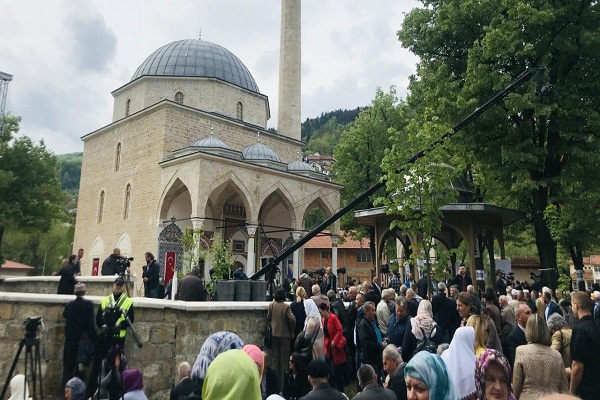Historic Mosque Reopened in Bosnia

Husein effendi Corbo, who served as the last imam at the mosque before it was blown up, said he has been hoping for 27 years that Aladza would reopen to serve Muslims in Foca, a town which is now in Republika Srpska, Bosnia’s Serb-dominated entity.
“For nearly 19 years, I was going to Aladza every single day, as I worked as the imam there from 1973, and when I received the news that it had been completely destroyed… it was one of the worst days in my life,” Corbo told BIRN.
“Today, my heart is full of happiness with the hope that Aladza will become a central point for all believers in this area and once again become a real pearl, as it once used to be,” he said.
The Aladza mosque was built between 1550 and 1551, and because of its architecture, structural proportions, and engraved and painted geometric and floral decoration, it was also known as the ‘painted mosque’.
Its painted ornamentation is in a typical Ottoman classical architectural style, and as it was the first mosque of its kind in the country, its design was emulated by many others that were built afterwards.
This is also one of the reasons why the Yugoslav authorities put it under state protection in 1950.
But on August 2, 1992, during the first year of the war, the mosque was blown up by Bosnian Serb troops – one of many mosques in the country that were destroyed.
The Bosnian prosecution in October 2018 indicted former Bosnian Serb soldier Goran Mojovic for participating in planting explosives and causing a blast that destroyed the mosque.
Mojovic was charged with committing a crime against humanity through the destruction of cultural, religious or historic monuments.
During the Ottoman period, 17 mosques were built in the town of Foca; five of them were destroyed during World War II, and the 12 remaining ones were destroyed during the 1992-95 war.
A memorial to destruction
Construction work on the rebuilding of the Aladza mosque began in October 2012 as joint effort by the General Directorate of the Waqf of the Republic of Turkey and the Waqf Directorate of the Islamic Community in Bosnia. Waqf is an Islamic charitable endowment.
Remzija effendi Pitic, the mufti of Gorazde, who was also part of reconstruction project, said that the ceremony for the reopening of Aladza Mosque was an event of the highest importance for the local Islamic community.
“Rebuilding this house of God was a demanding project in many ways. We managed [to do it], thanks to God, our will, effort and support from our friends. We are grateful to all those who contributed to this enormous project in any way and this is our best Ramadan gift to all of the believers,” Pitic told Fena news agency.
In front of the Aladza mosque, parts of the destroyed building that could not be used in its reconstruction will remain as a memorial to its destruction in 1992.
Senaid Zaimovic, head of the Waqf Directorate Sarajevo, said the reconstruction was “as genuine as possible”.
“We have drawings which date from the period when the mosque was built and we found them in the Istanbul Archives and the Waqf Archives Directorate of the Republic of Turkey,” Zaimovic said.
He explained that the total cost of the renovation of the mosque was just over two million euros.
Velimir Kostovic, the chief of Foca’s police department, said that the reopening ceremony was important for all the people of Foca, regardless of their religious affiliation.
“The Aladza mosque was always a symbol of Foca. Throughout the organizing [of the ceremony], we have not had any serious incidents and we hope that this festive opening will continue in that way,” Kostovic told Patria news agency.
The 2013 census in Bosnia and Herzegovina showed that Foca has 18,288 residents, the huge majority of them Serbs, with just 1,270 Bosniaks and 55 Croats.
In the last census before the war, in 1991, Foca had 20,790 Bosniaks, out of a total of 40,513 residents.
The town saw mass persecutions and killings of Bosniaks by Bosnian Serb forces during the war, and was the site of detention camps in which women and girls were raped and enslaved, court verdicts have established.
More than a dozen verdicts have been handed down by the Bosnian state court and The Hague Tribunal convicting Bosnian Serb soldiers of crimes in Foca.
Source: balkaninsight.com
 Most Commented
Most Commented 


